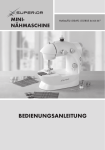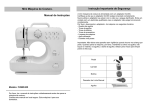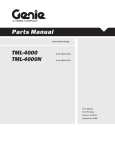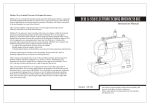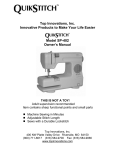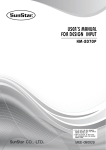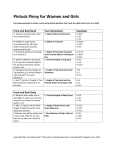Download Michley Electronics LSS-505 sewing machine
Transcript
TROUBLESHOOTING Problem No power or the machine runs slowly Problem cause Amendment ·Batteries are installed incorrectly ·Reinstall the batteries making sure they are the correct way around ·Batteries are low ·Use new batteries Mini multi-purpose sewing machine Instruction Manual ·Adaptor power inadequate ·Use compatible adaptor Skipping stitches Bobbin thread cannot be drawn up Thread keeps breaking ·Needle eye not in the middle ·Remove and re-insert the needle with the flat side of the needle to the back ·Needle bent ·Remove and re-insert a new needle ·Presser foot too loose ·Tighten the presser foot ·Lower thread has been used up ·Replace with new full bobbin ·Needle threaded incorrectly ·Re-thread the needle, making sure it is threaded from the front to the back ·Needle bent ·Remove and re-insert a new needle ·Needle shank not properly seated ·Remove and re-insert a new needle ·Thread tension dial, thread ·Loosen the thread tension guide or thread pulling bar between 3-5 number too tight Stitches too loose or uneven ·Thread blocked by upper bobbin ·Upper thread too loose Needle breaks ·Needle bent or deformed ·Pull out the spool pin and make the bobbin or thread run smoothly ·Remove and re-insert a new needle Model: FHSM-505 Please read the instruction book carefully before operating the sewing machine. Please save this manual in a safe place. This sewing machine is for Household Use. 10 FEATURES ADJUSTING STITCHING 1. As shown in the picture A, normal stitching shall have top and bottom threading neither over tight or loose. Top thread Cloth Bottom thread Fig.A 2. If the bottom threading looks like a straight line, which indicates the top thread is too loose. Please turn in thread damp clock wise to increase pressure until the stitching returns to normal. Fig.B 3. However, when the top thread looks like a straight line indicating an over-tight top thread, slowly turn the thread clamp anti clock wise to reduce pressure until the stitching back to normal. Fig.C Correct Disposal of this product This marking indicates that this product should not be disposed with other household wastes throughout the EU. To prevent possible harm to the environment or human health from uncontrolled waste disposal, recycle it responsible to promote the sustainable reuse of material resources. To return your used device, please use the return and collection systems or contact the retailer where the product was purchased. They can take this product for environmental safe recycling. 9 Please read all instructions before using this appliance carefully and keep them in a safe place for future use. FEATURES DRAWER On the side of the sewing machine (towards the rear) is a drawer for the handy storage of accessories BOBBIN WINDING Put a spool of thread on spool pin (Fig.11). Place the thread to the right of the bobbin wider tension disk Push the bobbin into the bobbin wider pin and push it to the left. (Fig.13) Wind thread clockwise around bobbin several times. Open the speed switch to start winding.(Fig.14) Stop winding after correct volume of thread is winded on bobbin. (Fig.15) Take bobbin off the spindle and cut the thread. IMPORTANT SAFETY INSTRUCTION This sewing machine is only suitable for domestic use. Do not use outdoors. Powered by an AC adaptor. The sewing machine must be switched off and the adaptor unplugged when: - Threading the needle - Changing the needle - Changing bottom bobbin - Changing parts - Cleaning the machine - After each use Important: - Never leave the sewing machine unattended in the presence of children. - When operating the sewing machine, keep your hands away from the needle, hand wheel, thread pulling bars and pattern selection dial. - To clean the sewing machine, simply wipe it with a soft cloth and never use any harsh chemical solutions. ACCESSORIES Fig.11 Fig.14 Fig.12 Fig.13 Fig.15 8 Foot controller 1 Thread spool 2 Bobbin 2 Needle threader 1 Needle 1 1 NAME OF PARTS FEATURES Front view Take up lever Upper thread tension dial Pattern selection dial Handwheel Thread Cutter Light Needle clamp screw Reverse button Power off & speed switch Drawer Bottom bobbin 8 STITCH FUNCTIONS 1. The sewing machine has a choice of 8 different stitch types /lengths. To select the stitch you require, look at the diagrams numbered 1-8 on the front of the sewing machine, choose the corresponding number on the dial is lined up with the arrow. For example, to select zigzag stitch (diagram number 2), simply turn the selector dial until the number 2 on the dial is lined up with the arrow. 2. Proceed to sew. 3. When you wish to change stitch type, turn the hand wheel on the side of the sewing machine to raise the needle to the highest point and set the pattern selection dial to the desired stitch type in the same way as above. Caution: When you wish to change stitch type, you must carry out step 3 first. REVERSE STITCH BUTTON Reverse sewing (back stitching) is useful for reinforcing the beginning and end of seams. To use this function proceed as follows: 1. Sew forwards as normal, and then press and hold down the reverse stitch button on the front of the sewing machine to sew backwards. 2. To sew forwards again simply release the reverse stitch button. Back view Bobbin winder pin Bobbin winder tension disk Bobbin winder stop SETTING THE SEWING SPEED This sewing machine has two sewing speeds. Push the ‘OFF ’button, into the right, to the ‘H’ position and the sewing speed will be increased, while in the ‘L’ position will reduce the speed. Presser foot lifter Presser foot AC/DC input Foot pedal input 2 WORK LIGHT If additional light is needed, press the light switch to turn the light ‘On’. Press the switch again to turn it ‘Off’. SEWING SLEEVES This sewing machine has been designed to sew sleeves or any narrow openings in garment. 1. Lift the presser foot. 2. Position the garment over the sewing arm. 3. Lower the presser foot and follow the regular sewing instructions. 7 SEWING CONNECTING THE SEWING MACHINE TO THE MAINS POWER SUPPLY 1. Turn the hand wheel on the side of the sewing machine anticlockwise to raise the needle to its highest position. Lift the presser foot and place the fabric you wish to sew under the presser foot (Fig.7). 2. Lower the presser foot (Fig.8). 3. The sewing machine can be operated in two ways: with the foot controller or with the “power off/speed switch”. To operate the sewing machine with the foot controller simply press your foot down on the pedal and to stop sewing at any time simply by releasing your foot from the controller. Alternatively, when you are ready to start sewing slide the “power off/speed switch” left to the low (L) position and the sewing machine will automatically start sewing slide the“power off/speed switch”right to the high position (H). In order to stop sewing slide the “power off/speed switch” to the off position (Fig.9). 4. Turn the hand wheel on the side of the sewing machine anticlockwise to raise the needle to the highest position. Lift the presser foot and pull out the thread tension release bar, then gently remove the fabric away from the sewing machine (Fig.10). 5. Cut the thread using the thread cutter. WARNING: When the sewing machine is in use do not touch the pattern selection dial. Note: Thickness of cloth sewed by this model: 0.3mm Best to use the machine to sew double layers of cloth, thus every stitch is available. Best to use No.6, No.7, No.8 stitch to sew soft cloth (thickness 0.3mm) or silk instead of other stitch patterns. 1. Make sure the “power off/speed switch on the front of the sewing machine is in the OFF position. 2. Connect the jack (A) to the DC input socket on the back of the sewing machine,and connect the three-pin plug (B) into the mains power supply. 3. Connect the foot pedal “C” to the sewing machine by inserting the AC power jack into the foot pedal input socket on the back of the sewing machine. 4. To operate the sewing machine you can either use the foot pedal (the power off/speed switch is in OFF position) for manual operation, or you can slide the“power off/speed” switch to the left (L) or to the right (H). Please note that both settings will switch on the sewing machine and allow automatic operation. The low setting (L) is slow, while the high setting (H) is fast. CAUTION: Whenever the sewing machine is not in use make sure it is switched off and unplugged from the mains power supply. INSTALLING THE BATTERIES 1. Make sure the “power off/ speed switch” is on the “Off” position. 2. Turn the sewing machine over on a flat surface and remove the battery compartment cover. 3. Insert 4×AA batteries into the compartment and put the battery cover. Fig.7 Fig.8 Fig.9 Fig.10 6 CAUTION: To prevent accidental start up of the sewing machine, always make sure that the “power off/speed switch” is in the “Off” position when inserting, or changing the batteries. 3 THRENDING THE SEWING MACHINE REPLACING THE BOBBIN Threading upper thread Caution: When threading the sewing machine make sure that the“power off/speed switch” is in the OFF position and follow the steps 1-6 below. Turn hand wheel counter clockwise until the needle is in the highest position. 1. Turn the hand wheel counter clockwise until the needle is in the highest position. Raise presser foot lifter. 2. Pull the slide plate forward and remove the empty bobbin 3. Leave 10cm thread tail from the new bobbin and put it in the bobbin case 4. Hold needle thread loosely with your left hand. Turn the hand wheel toward you with you, first lowering the needle and continuing until the needle comes to its highest position 5. Lightly pull up the needle thread and pick up the bobbin thread which will appear through the needle plate slot. Then pull both threads to the back of the machine, leaving 10cm thread tail. Caution: It is essential that both top and bottom threaded correctly. Check carefully and do practice stitch before beginning to sew. Very Important: Make sure you always use a metal bobbin, as otherwise the magnetized bobbin case will not be activated and there will not be tension on your bobbin thread. Fig.4 Fig.3 NEEDLE REPLACEMENT CAUTION: Remove the batteries and/or disconnect the AC/DC adapter before starting to replace the needle. 1. Turn the hand wheel to raise the needle to its highest position. 2. Hold the old needles and loosen the needle clamp screw. Remove the old needle and discard responsibly. 3. Insert the new needle into the clamp with the flat side toward the right. Be sure to push the needle clamp before tightening the needle clamp screw. 4.Tighten the needle clamp screw. Fig.1 Fig.5 Fig.2 4 5 Fig.6







